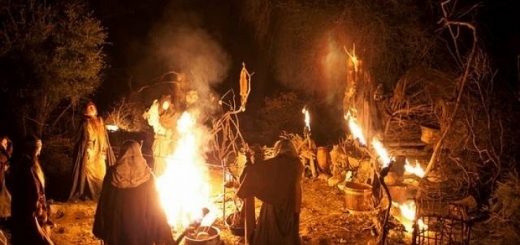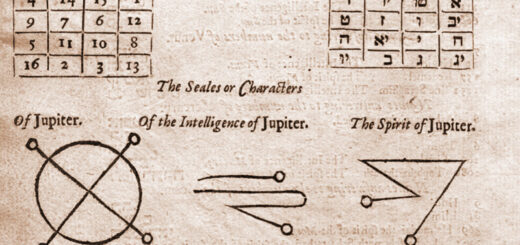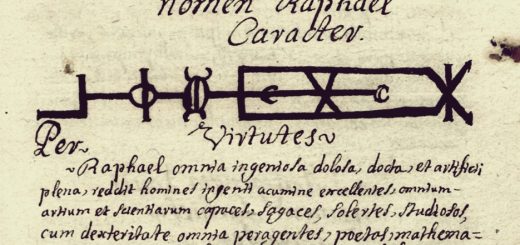Dybbuk or Dibbuk – the sticky ghost of the Ashkenazi
In Ashkenazic Jewish folklore a Dybbuk (Yiddish: דָּבַק, dāḇaq) is an evil spirit which enters into a living person, cleaves to his soul, causes mental illness, talks through his mouth, and represents a separate and alien personality. Dybbukim (plural) were generally considered to be souls which, on account of the enormity of their sins, were not even allowed to transmigrate and as “denuded spirits” they sought refuge in the bodies of living persons. The entry of a Dybbuk into a person was a sign of his having committed a secret sin which opened a door for the Dybbuk. Belief in Dybbukim was very common in Eastern Europe.
The term Dybbuk appears neither in talmudic literature nor in the Kabbalah, where this phenomenon is simply called “evil spirit.” (In talmudic literature it is sometimes called ru’aḥ tezazit, and in the New Testament “unclean spirit.”) The term was introduced into literature only in the 17th century from the spoken language of German and Polish Jews. It is an abbreviation of dibbuk me-ru’aḥ ra’ah (“a cleavage of an evil spirit”), or dibbuk min ḥa-hiẓonim (“dibbuk from the outside”). So the act of attachment of the spirit to the body became the name of the spirit itself. However, the verb davok (“cleave”) is found throughout kabbalistic literature where it denotes the relations between the evil spirit and the body, mitdabbeket bo (“it cleaves itself to him”).
Dybbuk exorcism
When possessed by a Dybbuk, a specially trained rabbi, alone is able to cast out this evil spirit, which usually leaves the body of its victim through the small toe, where a little orifice from which blood oozes marks the exact point of its exit. The kabbalistic literature of Yitzchak Luria‘s disciples contains many stories and “protocols” about the exorcism of Dybbukim. Numerous manuscripts present detailed instructions on how to exorcise them. The power to exorcise Dybbukim was given to ba’alei shem or accomplished Ḥasidim. They exorcised the Dybbuk from the body which was bound by it and simultaneously redeemed the soul by providing a tikkun (“restoration”) for him, either by transmigration or by causing the Dybbuk to enter hell. Moses Cordovero defined the Dybbuk as an “evil pregnancy.”
According to the Jewish Encyclopedia, full descriptions of successful acts of exorcism, where, however, the Dybbuḳ is still called by its older name “ruakh,” are given in Manasseh ben Israel’s Nishmat Ḥayyim (part iii., ch. 14; part iv., ch. 20). Another detailed description of a similar incident is reproduced in Ha-Shakhar (vi. 459, 697) from Moses Prager’s (Graf) Zera’ Ḳodesh (Fürth, 1696), and is curious from the fact that R. David Oppenheim, the celebrated book-collector, who was then rabbi of Nikolsburg, Moravia, is one of the signatories to the narrative. Dr. S. Rubin, in his Gilgul Neshamot, the German title of which is Die Metempsychose in Mythus und Kultur Aller Völker (Cracow, 1898), points out the connection between the ancient belief in the transmigration of souls and in possession by evil spirits, and that in the Dybbuḳim of modern times. He says at the end of his work (p. 29) that the belief in the wanderings of the soul “has come down to our time among the ẓaddikim and saints of the Ḥasidim, who cast out ‘gil-gulim’ and ‘Dyibbuḳim’ from insane people.”
Dybbuk in modern Judaism
In modern Judaism some rabbi’s take the Dybbuk serious while others regard the phenomena as superstition. The thing is that, though not called Dybbuks, in the 20th century, a lot of literature by non-Jews was written about the spirits of deceased people taking possession of the living and causing a lot of trouble. One of the best books on the subject Thirty Years among the Dead is the monumental work of Dr. Carl Wickland, a Swedish-American psychiatrist, dates back to 1924. In non-European cultures diseases, bad luck, mental illnesses are almost without exeption linked to evil spirits, demons or possession by spirits of the dead. This belief once was common among all Jews. See for example the Testament of Solomon. Christ and his disciples healed people by casting out the demons that made them ill.
the Dybbuk in theater play and movie

Members of the Bundist theater group Arvi perform the play The Dybbuk November 13 1926 Kalish Poland
The Dybbuk, or Between Two Worlds (Russian: Меж двух миров [Дибук], trans. Mezh dvukh mirov [Dibuk]; Yiddish: צווישן צוויי וועלטן – דער דִבּוּק, Tsvishn Tsvey Veltn – der Dibuk) is a play by S. Ansky, authored between 1913 and 1916. It was originally written in Russian and later translated into Yiddish by Ansky himself. The Dybbuk had its world premiere in that language, performed by the Vilna Troupe at Warsaw in 1920. A Hebrew version was prepared by Hayim Nahman Bialik and staged in Moscow at Habima Theater in 1922. The play, which depicts the possession of a young woman by the malicious spirit of her dead beloved, became a canonical work of both Hebrew and Yiddish theater, being further translated and performed around the world. The Dybbuk-theme also inspired several movie directors. The Dybbuk (Yiddish: דער דיבוק, Der Dibuk; Polish: Dybuk) is a 1937 Yiddish-language Polish fantasy drama directed by Michał Waszyński. It is was based on the play The Dybbuk by S. Ansky. We also find the Dybbuk theme in The Possession, a 2012 American-Canadian horror film directed by Ole Bornedal. Dayan D. Oualid created Dibbuk in 2019, a 33 minutes horror movie. Dan, a pious man is tasked by Sarah to examine her husband Eli. Dan thus brings together a “Minyan”, a group of ten Jewish individuals, in order to perform an exorcism according to a strict and tiresome ritual.
You may also like toe read:
Pulsa diNura
The real vampire in Russia and Slavonian countries
Historical werewolf cases in Europe
The incubus or succubus – nightmare or astral sex date?








